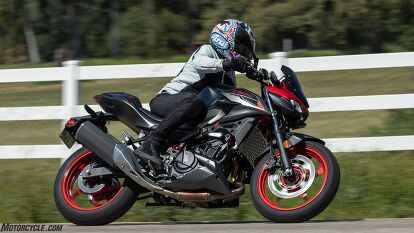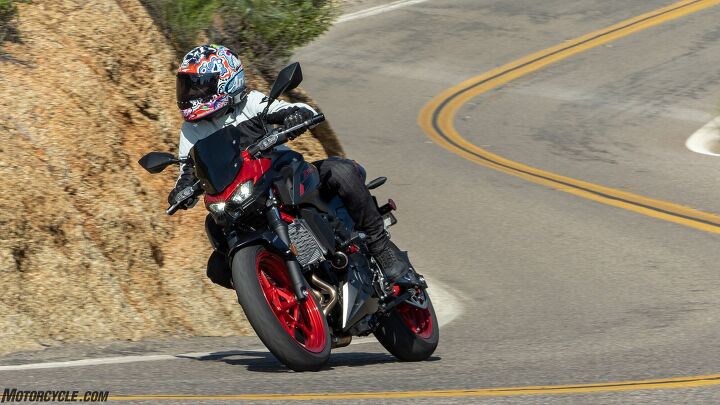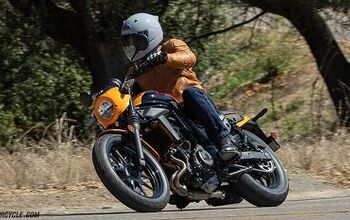2024 Kawasaki Z500 SE Review – First Ride
Displacement creeps alongside tech and styling updates
Every rider can fondly recall their first street motorcycle. Maybe it was a used 1980s “Honda Davidson” cruiser with miles of wear and tear. Or perhaps it was a shiny new lightweight sport bike, candy coated and bright like a Skittle. For most riders, this first motorcycle is their rite of passage into the world of riding. It will be dropped, stalled out, get a burnt up clutch, and valuable lessons will be learned. Inevitably, like a favorite childhood toy, the day will come when a rider has simply outgrown their first bike.
2024 Kawasaki Z500 SE
The Z400 evolves into the Z500, boasting improved power and top speed figures and refined styling while still maintaining a reputation for being a well-handling beginner bike. The "SE" model includes a host of accessories such as frame sliders, rear seat bowl, and the most notable being the full-color TFT dash.
Reviewer's Score: 85%
Engine | 18/20 | Suspension | 12/15 | Transmission | 8/10 |
Brakes | 8/10 | Instruments | 5/5 | Ergonomics | 8/10 |
Appearance | 8.5/10 | Desirability | 8.5/10 | Value | 9/10 |
Highs
- The upgrade in performance is noticeable
- New riders will appreciate the SE's additional features
- TFT dash is well-designed with good information hierarchy
Sighs
- Buzzing sensation above 6,500 rpm
- Non-adjustable suspension (aside from shock preload)
- Non-adjustable levers
The new Z500 challenges the traditional notion of a first bike altogether. What would it take to prolong the usual “first bike” expiration date? Can an entry-level naked bike live in the garage for more than a few years – could it live there indefinitely?
The new and the old
The new Z500 is a predictable progression from the Z400. The old reliable parallel twin engine has been punched out from 399cc to 451cc, a welcome bump in torque and horsepower for those who still felt the 400 could use a little extra push on the freeway. The chassis remains identical to the previous generation, bringing back all the same components in regards to frame, subframe, suspension, and brakes.
What is new is that Kawasaki has updated the bodywork of the Z model. Thanks to in-depth marketing surveys Kawasaki learned that looks and style are the number one priority of entry level bike shoppers, and so the new Z500 was sculpted to appeal to that crowd with sharper lines and aggressive styling. Another tidbit filtered through the data results indicated riders were wanting more technology in the dash and connectivity with their phones, something often overlooked on affordable lightweight models. With that in mind, Kawasaki updated the display on the base model to full-LCD instrumentation and the Z500 can now connect with the Rideology app. What’s more, the Z500 is now available in an up-spec edition called the “SE” which includes a host of add-ons Team Green thought a new rider would appreciate (more on that soon).
To round out the bullet points in the “new” category, the Z500 is now outfitted with a new seat shape, LED headlight, taillight, mirror stays, and hazard switch.
Ergonomically speaking
The Z400 was already well known as an approachable motorcycle, and since the same chassis and engine block are deployed on the Z500 not much has changed in that department. The seat height is 30.9 inches so for a rider of my height (five feet four inches) it is easy to flat foot the Z500. Because of its lightweight (at 366 pounds) and low seat height, maneuvering the Z500 for parking or U-turns was a breeze.
The rider triangle did surprise me with a bit more bend in the knees, but overall it was an upright and neutral riding position. Speaking with my taller counterparts on the ride, they said they stayed reasonably comfortable in the saddle all day. They did notice however that large feet would make contact with the muffler, whereas my dainty little tootsies had no such issue. As it surely surprises no one, the Z500 does seem better suited for riders of smaller stature.
For beginner riders, learning the new dynamics of shifting gears on a motorcycle and controlling the throttle can be daunting. The Z500 may have grown more powerful, but the throttle response remains predictable and progressive. What is really outstanding is how featherlight the clutch lever is. Combined with the slip and assist clutch, shifts are easy and the usual hand fatigue from constant shifting is greatly reduced.
Displacement Creep
The Ninja 250cc grows to 300cc, which then grows to 399cc. The stripped down Z400 was introduced in 2019 and now it joins this latest growth spurt to 451cc. At what point does an entry-level bike’s engine outgrow the segment altogether? According to Kawasaki’s research with both dealers and riders, keeping it under 500cc is the sweet spot.
The fuel-injected parallel-twin engine of the Z400 now sports a 70.0mm x 58.6mm bore and stroke to achieve the new golden standard of 451cc. The crankshaft, connecting rods, and pistons have all been tweaked and the compression ratio optimized for the new displacement. Not having to scale up the engine block means the price stays low and the well-sorted handling characteristics of the baby Z still remain. Like the height measurements on the door frame of the family home, Kawasaki notches another mark in the Z model’s growth.
The punched out Z500 now produces a claimed 51 horsepower and 31.7 pound feet of torque. Compared to the older gen Z400 at 43 hp and 24.5 lb-ft of torque, that is absolutely a noticeable upgrade. Riders surveyed expressed having more usable power around 70 mph was ideal, and so the newly revamped power plant meets the need. I can confirm that keeping up with San Diego’s convoluted freeway system was a non-issue for the Z500. It competently kept pace and had an extra punch left in the RPM range in sixth gear for the occasional overtake. The one complaint I do have about the P-twin is that it does get buzzy above the 6,500 RPM mark, particularly in the seat. For those logging many miles at top speeds, get ready to have a numb derrière.
The newfound torquieness of the Z500 came into focus on the surface city roads. Pouncing off the line and banging through the short gears in quick bursts stoplight to stoplight was smile inducing. Same story out in the canyon roads of Southern California. In the right gear the Z500 propels out of the corners, but the powerband is still plenty forgiving if you carry a gear too high.
As for the handling characteristics of the Z500, the tried and proven chassis is up to the task of benign city commuting or spirited backcountry weekend riding. The rear spring is perhaps just a touch stiff, as many of the city potholes were jarring to roll through. Yet the front fork provided excellent feedback in tight cornering and the brakes were plenty proficient under heavy trail braking. Simply put, I had complete trust in the cornering capabilities of the Z500.
Blurring the line
Is the Z500 still really a beginner bike? The question looms heavy on my mind as Kawasaki pokes at the edges of the genre in power, performance, and now with an up-spec “SE” model. Entry level models are usually only offered in one basic and budget friendly trim, with up-selling reserved for the next size up, not an accessories package.
The SE edition tacks on over $1,000 worth of accessories, including the full color TFT dash that can be found on premier models such as the ZX-6R. This dash imparts the most critical data in a hierarchy that is understandable and quick to read. It does feel like a luxury on the little Z. What still falls short from delivering is the Rideology app. It took some help from a few Kawasaki reps to get it paired via Bluetooth, and though I tried to track and log my ride the app only caught 28 minutes of the excursion. While I generally like the idea of the app to track maps, log riding data, and keep tabs on a maintenance schedule, it just unfortunately does not work as intended.
Price wise, the Z500 is attractive at $5,599 (or $6,299 for SE model). Especially considering the improved power and finish of the motorcycle. When compared to other motorcycles in the same segment, the Z500 wins the most bang for your buck argument since the Honda CB500F costs $6,799 and all other competitors hover in the 300-400cc range.
I believe the Z500 absolutely extends the life expectancy of a “beginner bike”. A new rider in a dense urban environment can easily enjoy the spoils of this machine for 3-5 years. I have no doubt there is a sizable rider segment that could entertain the Z500 as a “forever” bike (though for me personally, I’d opt for a 650cc or larger machine for the long haul). In a beginner bike market that is completely saturated, the Z500 is an attractive evolution of a fan favorite.
In Gear

- Helmet: Aria Regent -X Jungle 2
- Protection: Alpinestars Stella Tech Air 3
- Jacket: Dainese Sevilla Air Lady Tex
- Pants: Dainese Slim Lady Tex
- Gloves: Alpinestars Stella SP-2 v2
- Shoes: REV’IT Arrow Women’s Shoe
2024 Kawasaki Z500 SE | |
|---|---|
Engine | 4-stroke, liquid-cooled, DOHC, 4-valve cylinder-head, Parallel-Twin |
Displacement | 451 cc |
Bore & Stroke | 70.0 x 58.6 mm |
Horsepower | 51.0 hp at 10,000 rpm (claimed) |
Torque | 31.7 lb-ft. at 7,500 rpm (claimed) |
Compression Ratio | 11.3:1 |
Fuel System | DFI w/ dual 32 mm throttle Bodies |
Ignition TCBI with Digital Advance | TCBI with digital advance |
Transmission | 6-speed with positive neutral finder |
Final Drive | Sealed chain |
Rake/Trail | 24.5° / 3.6 in. |
Front Tire Size | 110/70-17 |
Rear Tire Size | 150/60-17 |
Wheelbase | 54.1 in. |
Front Suspension | 41mm hydraulic telescopic fork; 4.7 inches of travel |
Rear Suspension | Horizontal back-link shock with adjustable spring preload; 5.1 inches of travel |
Front Brake | Single 310mm semi-floating disc with 2-piston caliper and ABS |
Rear Brake | Single 220mm disc with single-piston caliper |
Fuel Tank Capacity | 3.7 gallons |
Seat Height | 30.9 inches |
Curb Weight | 370.4 pounds/372.6 pounds for 50-state model (claimed) |
Warranty | 12 months |
Kawasaki Protection Plus | 12, 24, 36 or 48 months |
We are committed to finding, researching, and recommending the best products. We earn commissions from purchases you make using the retail links in our product reviews. Learn more about how this works.
Become a Motorcycle.com insider. Get the latest motorcycle news first by subscribing to our newsletter here.
More by Jen Dunstan



























































Comments
Join the conversation
Great writing and insights Jen! Still a beginner's bike, but one that won't need replacement in a year or two. Great timing on Kawasaki's part. The updated KTM and Husky singles and Triumph's lovely new 400s would have taken a lot of the Z 400's sales. The Z500's improved looks, extra 50cc and cylinder, and SE option make it a lot more competitive.
The only negative I see is the vibration that gets tiring very quickly. Other than that, great bike. I do travel at 70 mph a lot, so I’ll look elsewhere for my thrills.